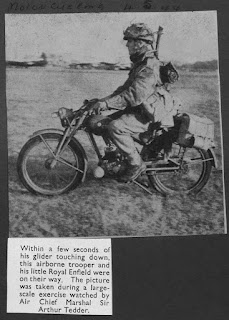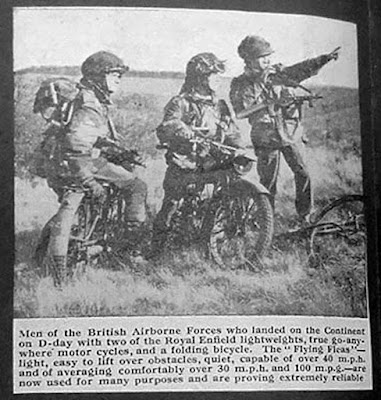 |
| Royal Enfields line up for wartime duty in The Tatler of Nov. 29, 1939. Headlights lack the blackout shields that would become standard. |
Royal Enfield went to war with the rest of Britain, in 1939. Obviously, war was important to a company with the motto "Made Like a Gun," and equipped with factories ready to churn out military motorcycles.
Press accounts mentioning the company's contributions to the war effort were clipped and pasted into scrapbooks now in the possession of the Royal Enfield Owners Club (UK).
REOC archivist Bob Murdoch has photocopied the clippings, including those from the war years.
A glance at the resulting images gives a look into the wartime lives of Royal Enfield employees, their fellow citizens, and the motorcycling press of those days.
The emphasis of the press, of course, was on patriotism, and motorcycles' contribution to victory.
 |
| Royal Enfields would clear the roads "in the event of invasion." Clipping from The Motor Cycle of Aug. 15, 1940. |
British motorcycles would make an incredible contribution, particularly as every sector of British life suddenly seemed convinced of the need to carry messages, direct traffic and patrol on two wheels.
Royal Enfield would help supply the motorcycles to make it all possible. The fact that one model of its motorcycles could arrive on the battlefield by parachute only added luster to the scrapbook record.
Gearing up the war effort took some time. Britain entered the war in September, 1939, but as late as November of that year a hopeful businessman was opening a new Royal Enfield dealership.
As an advertising promotion he intended to give away model airplane kits to brighten the hours customers would spend stuck at home in the blackouts. (There was as yet no Blitz to provide real excitement. Enemy airplanes carrying bombs would arrive soon enough.)
If Britain was to have motorcycle messengers, men and women had to be trained to ride the things, and not just on roadways. So Royal Enfield put its vast knowledge of "trials" riding to use.
 |
| Royal Enfield's Jack Booker lectures the Dispatch Riders in this 1942 clipping. |
A clipping from the Redditch Indicator for March 31, 1942 describes a trials contest pitting teams from Home Guard units and local motorcycle clubs against entrants from the 11th Armored Division including Lt. Col. "Tommy" Spann. The course was 36.5 miles long, and challenging.
"The last section, Dirty Lane, was in its worst possible state... Second-Lieutenant R.V. Slinn played to the gallery and found that a handful of twist-grip was not the correct method." The premier award went to Sergeant R.D. Reid, of the Royal Enfield Works Home Guard (Royal Enfield had its own Home Guard company).
Motor Cycling magazine did an April 21, 1942 spread on one training session, with Royal Enfield executive Jack Booker lecturing Dispatch ("Despatch" in British English spelling) Riders. The Enfield Company of the 9th Worcester Battalion of the Home Guard "was largely responsible for the organization...
"Incidentally, the Enfield Cycle Co. presented a silver cup for the best individual performance and also six tankards for the winning Worcester team."
On one such occasion, a clipping notes, "Jack Booker (Royal Enfield) demonstrated on an extraordinarily twisty path, zig-zagging between the trunks of closely set beech trees. There were right-angle bends, hairpin turns and tree roots to be negotiated, with bend following bend at little more than a machine's length.
"To go through this taped hazard without having to reverse or otherwise manhandle the machine, at one point at least, seemed impossible, but Booker rode through time after time without even waving a foot, thus showing what can be achieved in the matter of machine control."
 |
| Royal Enfield's military motorcycles were big news. This clip is from Motor Cycling for Nov. 30, 1942. |
Not everyone at the factory was giving "his all" to the war effort.
Thomas Croft was fined at Redditch police court for failing to fire-watch at his place of employment, the Enfield Cycle Company. His excuse was that he was tired from working all day to prune trees on his property. The newspaper clipping dutifully went into the scrapbook.
Royal Enfield's "WD" (War Department) motorcycles were big news in the motoring press. "Three tool boxes," one article enthused. But there was a little secret brewing.
 |
| Motor Cycling magazine showed off Royal Enfield's Flying Flea in the issue of May 11, 1944, before D-Day. |
At last it could be told: The Motor Cycle magazine crowed that its editor Arthur Bourne's advocacy of lightweight motorcycles had won approval.
"The Motor Cycle of October 28th, 1943, administered a genuine shock to many riders who were previously ignorant that the Army has picked 125cc lightweights for military work," a subsequent edition reported.
Now that the "Fleas" (the term was used for both the Royal Enfield and James lightweights) were no longer a military secret, there are many clippings applauding the little bikes as ideal for military service. A very occasional photo would even appear of them in use by the military.
 |
| Photo caption in The Motor Cycle for Nov. 22, 1944 implies that the Royal Enfields are in France, but it may show a training exercise. |
A parade of women dispatch riders in London impressed The Motor Cycle in January, 1944.
"Dressed in green battle-dress and with half-length waterproof coats and crash helmets, the girls on parade made a brave show of colour. Most of them are typists and clerks in the Government service.
"They have been trained by police motor cyclists. Their average age is 20, and they have done a lot of night riding... There followed a ride past. The men sat their Triumphs as ever, and the neat D.R.-ettes, on their khaki-finished Royal Enfields, were not outdone. There were about a hundred -- and it was impressive."
 |
| The Motor Cycle of Jan. 13, 1944 applauded their show of "colour," which could only have meant lipstick. |
After victory, a 1945 clipping noted that, like many others, "Victor Mountford, after six years of Army service, has now returned to the sales department of the Enfield Cycle Co. Ltd."
Mountford had gone to France in 1940 with the 8th Battalion of the Worcestershire Regiment, "coming back via Dunkirk in June of that year," the clipping noted.
The article didn't need to spell out what the word "Dunkirk" signified.
Having started as a subaltern in the regiment, by demobilization Mountford was a major and second in command of his old battalion. He would thereafter always be called "Major" Mountford.
 |
| Royal Enfield executive Victor Mountford spent six years in the service. |
Royal Enfield motorcycles would return to civilian life as well.
From the Glasgow Evening Times of July 18, 1946:
"Several hundred more cycles were auctioned today at the Ministry of Supply Depot, Meiklewood Road, Glasgow. This was the second day of the three-day sale of 1,100 Army cycles, now surplus to Service requirements... On offer today were a variety of well known makes, including Triumphs, Ariels, Enfields, B.S.A.s, Matchless and Norton."
Royal Enfield refurbished many of its WD models and offered them to the public in civilian paint. These were welcome and they would do, until new post-war models like the redesigned Bullet were ready.



























My grandmother, Betty Joan Gowers (nee Wood) is on the far right in the photos of the Wrens. Honor Blackman is also in the photo :)
ReplyDeleteThank you for letting us know. Can you tell us more about her service, or the unit she was part of?
Delete